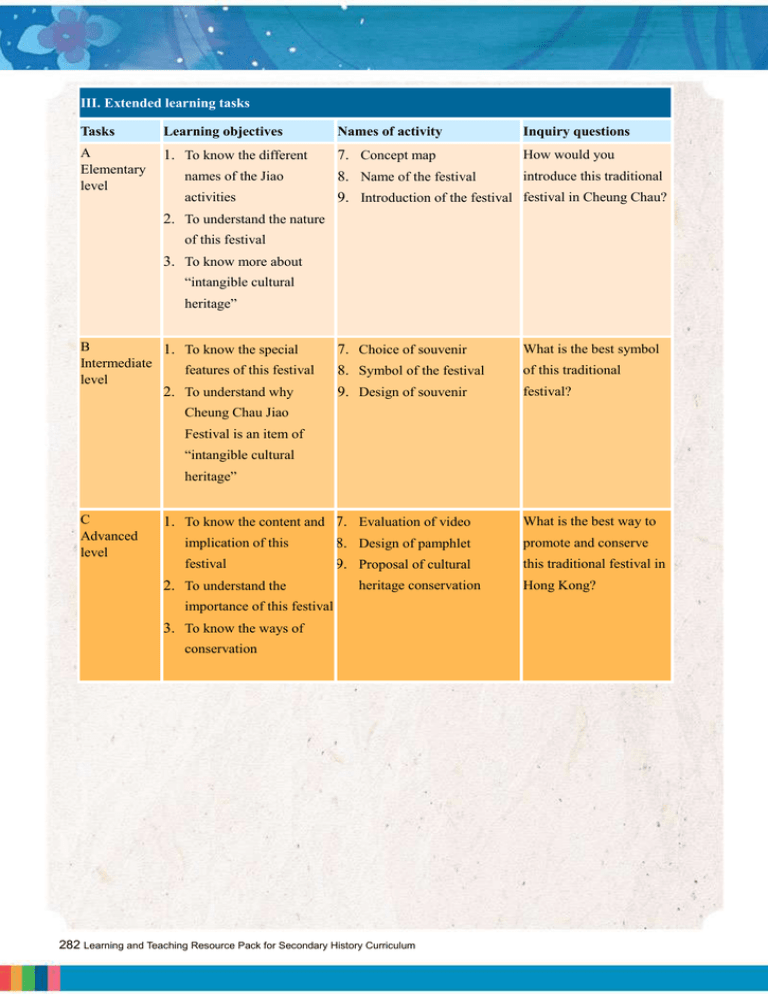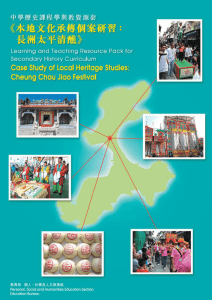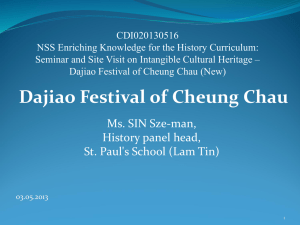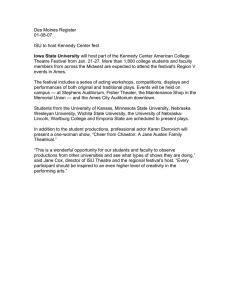Dajiao 2 3 Exemplars Eng
advertisement

III. Extended learning tasks Tasks Learning objectives Names of activity A Elementary level 1. To know the different How would you 7. Concept map introduce this traditional 8. Name of the festival 9. Introduction of the festival festival in Cheung Chau? names of the Jiao activities Inquiry questions 2. To understand the nature of this festival 3. To know more about “intangible cultural heritage” B 1. To know the special Intermediate features of this festival level 2. To understand why 7. Choice of souvenir 8. Symbol of the festival 9. Design of souvenir What is the best symbol of this traditional festival? Cheung Chau Jiao Festival is an item of “intangible cultural heritage” C Advanced level 1. To know the content and 7. implication of this 8. festival 9. 2. To understand the Evaluation of video What is the best way to Design of pamphlet promote and conserve Proposal of cultural this traditional festival in heritage conservation Hong Kong? importance of this festival 3. To know the ways of conservation 282 Learning and Teaching Resource Pack for Secondary History Curriculum III. Extended Learning A Elementary task Inquiry question: How would you introduce this traditional festival in Cheung Chau? A7 Concept map What do you know about the traditional festival in Cheung Chau? Watch the video and complete the following concept map with your own knowledge. Video clips: Cheung Chau Jiao Festival OR other programmes such as 長洲太平清醮 http://www.youtube.com/watch?v=bJUfr_PUqJA for 5” (Last access 3 January 2014) 吾土吾情 http://www.youtube.com/watch?NR=1&feature=endscreen&v=gMWQRFTBx3A http://www.youtube.com/watch?feature=endscreen&v=J6SM2p_wiEM&NR=1 (Last access 3 January 2014) Teaching tips: Teachers can guide the students by asking the following questions: 1. When, where and by whom is the Cheung Chau Jiao Festival organized? 2. What are the religious and artistic elements of the Cheung Chau Jiao Festival? 3. Why has the race of snatching buns on the bun towers appeared in the Cheung Chau Jiao Festival in recent years? 4. What are the risks that the Cheung Chau Jiao Festival has faced at the social level in recent years? Case Study of Local Heritage Studies: Cheung Chau Jiao Festival • Exemplars of Learning and Teaching Activities 283 Who (participants): 1. ________ people When (time of origin): Late _____th century Who (deities): 1. Pak Tai Where (temple): Pak Tai Temple 2. ________ people 2. _________ 3. Cantonese people 3. Earth God 4. _________ When (time of celebration): The ____th month of the lunar calendar Where (location): ________ Street, Cheung Chau Basic information Religious aspect Cheung Chau Jiao Festival Artistic aspect Social aspect What (rituals): 1. Inviting the sacred ones (i.e. deities) 2. _______________________ 3. Purifying the altar and Consecration 4. _______________________ 5. Feeding the water ghosts and relieving them from suffering 6. Sending off the flower boat 7. Handing out talismans 8. _______________________ _______________________ 9. Great offering to the wandering spirits 10. _______________________ _______________________ 11. Hailufeng _______________ _______________________ What (folk and Why (Reasons for traditional arts): artistic development What (threats): 1. _______________ related to the festival): 1. Knowing little about the 2. Qilin dance 1. Social identity / 3. _______________ Social _________/ 4. ___________ craft Sense of __________. 5. Devotional Cantonese operas 6. _______________ _______________ _______________ 2. Bustling, festive atmosphere 3. Attracting a lot of _____________ 4. Importing techniques from the ___________ region process of ____________ 2. _____________ of Cheung Chau residents. 3. Gradual _______________ of small-scale industries in Cheung Chau 4. Reduction in the availability of ______________ 5. _____________ in size of operation 6. Simplification of rituals 284 Learning and Teaching Resource Pack for Secondary History Curriculum Suggested answer (with the basic information): Who (participants): 1. Huizhou people When (time of origin): Late 19th century Who (deities): 1. Pak Tai Where (temple): Pak Tai Temple 2. Chaozhou people 2. Ghost King 3. Cantonese people 3. Earth God 4. Mountain God When (time of celebration): The 4th month of What (rituals): 1. Inviting the sacred ones (i.e. deities) 2. Cleaning the neighbourhood 3. Purifying the altar and consecration 4. Offerings & repentances 5. Feeding the water ghosts and relieving them from suffering 6. Sending off the flower boat 7. Handing out talismans 8. Second composite-scene parade 9. Great offering to the wandering spirits 10. Snatching buns on bun towers 11. Hailufeng white-characters opera the lunar calendar Where (location): Pak Tai Street, Cheung Chau Basic information Religious aspect Cheung Chau Jiao Festival Artistic aspect Social aspect What (folk and Why (Reasons for traditional arts): artistic development 1. Colour floats related to the festival): What (threats): 2. Qilin dance 1. Social identity / 1. Knowing little about the process 3. Lion dance Social coherence / 4. Paper craft Sense of belonging. 5. Devotional Cantonese opera 6. Snatching buns on bun towers 2. Bustling, festive atmosphere 3. Attracting a lot of tourists 4. Importing techniques from the Foshan region of change 2. Emigration of Cheung Chau residents. 3. Gradual disappearance of small-scale industries in Cheung Chau 4. Reduction in the availability of resources 5. Shrinking in size of operation 6. Simplification of rituals Case Study of Local Heritage Studies: Cheung Chau Jiao Festival • Exemplars of Learning and Teaching Activities 285 A8 Name of the festival Would you like to call the festival ‘Taiping Qingjiao’, ‘bun festival’ or other names? Explain your answer. Name of the festival Reason(s) Implication Suggested answers for A8 Name of the Cheung Chau Bun Festival festival Reason(s) ˙ easy to remember, especially for foreigners ˙ lucky bun: related to both the exciting race of snatching buns on the bun towers and the religious meaning of blessing others Implication ˙ focus more on its attraction to tourists rather than its religious tradition. Name of the Taiping Qingjiao of Cheung Chau festival Reason(s) ˙ There are different jiao rituals in each day of this annual event, and these are all conducted by Taoist ritual masters. ˙ Conventionally, residents of Cheung Chau have called it the Cheung Chau Taiping Qingjiao. Implication ˙ more authentic as it is a traditional religious practice in Cheung Chau Name of the Free answer festival Reason(s) Any reasonable answers Implication Any reasonable answers 286 Learning and Teaching Resource Pack for Secondary History Curriculum A9 Introduction of the festival To introduce the festival, you have to work individually or in pairs and you are required to 1. select 1-4 pictures (primary or secondary source, or own drawing) that show(s) the characteristics of the Festival related to intangible cultural heritage and paste it/them to the spaces provided. 2. 3. describe the key message of the pictures; and explain the reasons for choosing the picture(s). Picture 1 Picture 2 Description of the picture: Description of the picture: Reasons for the choice: Reasons for the choice: Picture 3 Picture 4 Description of the picture: Description of the picture: Reasons for the choice: Reasons for the choice: Case Study of Local Heritage Studies: Cheung Chau Jiao Festival • Exemplars of Learning and Teaching Activities 287 Sample for A9 Picture(s) with caption The bun towers Description of the picture Reasons for the choice These big and small bun towers made of lucky buns are located in the playground outside the Pak Tai Temple. Sponsors of the activities include local communities, kaifong associations and some charitable organizations. These bun towers are made to thank the deities and bring good luck to everyone. As reported by the local media, the race of snatching buns on the bun towers is one of the most eye-catching activities of the Cheung Chau Jiao Festival. Apart from the local residents of Cheung Chau, tourists are also attracted to obtain the buns distributed by the activities organizer for their implications of peacefulness. As the bun towers have become the well-known icon of the Cheung Chau Jiao Festival, the race of snatching buns on the bun towers becomes the representative medium that unites the local residents and tourists. Marking Total 1. Picture(s) chosen: clear, relevant 2 2. Description: clear, relevant, able to identify the key message 4 3. Reasons: clear, logical, related to the characteristics of the Festival and 4 its nature as an intangible cultural heritage 10 Other comments: 288 Learning and Teaching Resource Pack for Secondary History Curriculum Marks B Intermediate task Inquiry question: What is the best symbol of this traditional festival? B7 Choice of souvenir Look at the souvenirs in the pictures and do the two following tasks: 1. Search the souvenirs of this traditional festival that are not shown in the picture and paste the photos or images of these souvenirs onto the area below. Souvenirs which I can find from *books/internet/my own collection: * Delete where appropriate Case Study of Local Heritage Studies: Cheung Chau Jiao Festival • Exemplars of Learning and Teaching Activities 289 2. Referring to Task 1, which souvenir do you like most? Explain your answer. Your choice Reason Suggested answer for task 2 Your choice Free answer Reason Free answer: Students may refer to the design, the price, the target recipient or other factors. 290 Learning and Teaching Resource Pack for Secondary History Curriculum B8 Symbol of the festival Nowadays, the ‘lucky bun’ has become the symbol of the Cheung Chau Jiao Festival. Do you know why? Watch the video and find out the reasons. Video: Cheung Chau Jiao Festival Attractions of Characteristics of the lucky bun Why it is chosen as the symbol Other items Why they are not chosen as the symbol the ‘lucky bun’ Other items less appropriate Case Study of Local Heritage Studies: Cheung Chau Jiao Festival • Exemplars of Learning and Teaching Activities 291 Suggested answer Attractions of Characteristics of the lucky bun Why it is chosen as the symbol the ‘lucky bun’ Round shape of the buns & the Cute; compatible with different products; implication of ‘luck’ brings blessings With different flavours Delicious; a good idea for arranging cookery class The race of snatching buns on the bun Exciting; widely covered by the media towers Attractive to different kinds of people Other items Other items Why they are not chosen as the symbol less appropriate Lion dance Not so unique, since there are also lion dances in other occasions. Devotional Cantonese operas Not so unique, since there are also devotional Cantonese operas around the Buddha’s Birthday in many places. Colour floats parade Not so unique, since there is also a parade in the evening of the 2nd Chinese New Year Day 292 Learning and Teaching Resource Pack for Secondary History Curriculum B9 Design of souvenir You are required to complete the table according to the following instructions: 1. design a brand-new souvenir for the festival that is not related to the lucky bun; 2. describe the features and meaning of the souvenir and highlight the characteristics of the festival and its nature as an intangible cultural heritage; and 3. give a 5-minute presentation to the whole class to promote the product. You may work in pair or in group. The product and its features Link with the festival and intangible cultural heritage Class Format Content presentation Case Study of Local Heritage Studies: Cheung Chau Jiao Festival • Exemplars of Learning and Teaching Activities 293 Sample for B9 The product A commemorative stand featuring the Pak Tai Temple and its features Link with the Festival Class presentation Pak Tai Temple is one of the central places of religion and traditions among the Cheung Chau residents. It is also the starting point and the destination of the composite-scene parades. Even the race of snatching buns on the bun towers, i.e. the finale of the Jiao Festival, is also held in the football field near the Pak Tai Temple. Therefore, the Pak Tai Temple can be regarded as the focal point of the Cheung Chau Jiao Festival. Format Content The students shoot and edit a commercial clip of about 30 seconds, and play it during their presentation in the lesson. A granny who is physically immobile recollects and narrates the good old days to her grandchildren, and expresses how much she misses the bustling and jolly atmosphere of the Cheung Chau Jiao Festival. She wants to visit Cheung Chau again and take part in the celebration of the Jiao Festival. Thus, her grandchildren try their best to make a commemorative stand featuring the Pak Tai Temple according to its photos, showing their love and care for their granny. Marking Total 1. Design: interesting; creative; feasible 3 2. Description: clear; relevant; interesting; related to the characteristics of 4 the festival and its nature as an intangible cultural heritage 3. Class presentation: clear; able to sell the product; within the time limit 3 10 Other comments: 294 Learning and Teaching Resource Pack for Secondary History Curriculum Marks C Advance task Inquiry question: What is the best way to promote and conserve this traditional festival in Hong Kong? C7 Evaluation of video 1. Do you think the video included in this package provides adequate information to explain why the Cheung Chau Jiao Festival is inscribed onto the Third National List of Intangible Cultural Heritage? Watch the video and explain your answer. Video: Cheung Chau Jiao Festival Meaning of intangible cultural heritage Characteristics of the Cheung Chau Jiao Festival mentioned in the video Relevant information provided (Yes or No) It is transmitted from generation to generation. It is constantly recreated by communities and groups in response to their environment, their interaction with nature and their history. It provides the communities and groups with a sense of identity and continuity, thus promoting respect for cultural diversity and human creativity. It belongs to the practices, representations, expressions, knowledge, skills, as well as the instruments, objects, artifacts and cultural spaces associated with the UNESCO Convention for the Safeguarding of the Intangible Cultural Heritage 2003. Communities, groups and, in some cases, individuals recognize them as part of their heritage. It is manifested in one of the following domains: oral traditions and expressions, including language as a vehicle of the intangible cultural heritage; performing arts; social practices, rituals and festive events; knowledge and practices concerning nature and the universe; traditional craftsmanship. Case Study of Local Heritage Studies: Cheung Chau Jiao Festival • Exemplars of Learning and Teaching Activities 295 Suggested answer Meaning of intangible cultural heritage Characteristics of the Cheung Chau Jiao Festival mentioned in the video It is transmitted from generation to generation. An annual event since the late 19th century Yes It is constantly recreated by communities and groups in response to their environment, their interaction with nature and their history. Changes in date, the race of snatching buns on the bun towers, introduction of the parade (see A3 Task 1 for details) Yes It provides the communities and groups with a sense of identity and continuity, thus promoting respect for cultural diversity and human creativity. Since the 19th century, the festival has been held every year without any break. The fundamental religious rituals of the Hailufeng region is carried on, thus providing a sense of identity and continuity. On the other hand, it can also adapt to social and economic changes and unite different ethnic groups on the island. It also takes in various cultural elements, e.g. Cantonese operas, lion dance, colour floats, etc. It brings into full play its creativity, and turns the traditions of Huizhou and Chaozhou people in Cheung Chau into a traditional activity of the Cantonese people and other ethnic groups as well. Yes It belongs to the practices, representations, expressions, knowledge, skills, as well as the instruments, objects, artifacts and cultural spaces associated with the UNESCO Convention for the Safeguarding of the Intangible Cultural Heritage 2003. Everything e.g. the paper effigy of the Ghost King, the gongs and drums, the colour floats, etc. Yes 296 Learning and Teaching Resource Pack for Secondary History Curriculum Relevant information provided (Yes or No) Meaning of intangible cultural heritage Characteristics of the Cheung Chau Jiao Festival mentioned in the video Relevant information provided (Yes or No) Communities, groups and, in some cases, individuals recognize them as part of their heritage. Residents of both Cheung Chau and Hong Kong try to keep it as part of their tradition through organizing and sponsoring the festival. Yes It is manifested in one of the following domains: oral traditions and expressions, including language as a vehicle of the intangible cultural heritage; performing arts; social practices, rituals and festive events; knowledge and practices concerning nature and the universe; traditional craftsmanship. Cheung Chau residents being mobilized to donate money, take part in worshipping and activities of entertaining the deities (social practices, rituals and festive events). Yes Making of folk crafts by craft masters from the Hailufeng region. The most important paper craft items are the three giant deity statues of the Ghost King, the Earth God and the Mountain God, which are about five metres tall. 2. Is the video “Cheung Chau Jiao Festival” useful as a media to let the public know and understand the continuities and changes of this traditional festival? Suggested answer: Yes, it is useful. It has a good coverage of different aspects which include the following: - Origin of the festival - changing role of different clans in conserving the festival - traditional religious rituals with the addition of new elements - interview of the paper craft masters about the heritage of skills in making the folk craft - interview of historians and experts about the need and ways of cultural conservation Case Study of Local Heritage Studies: Cheung Chau Jiao Festival • Exemplars of Learning and Teaching Activities 297 C8 Design of pamphlet To promote cultural tourism in Hong Kong, you are required to design a pamphlet (printed or electronic) to: 1. 2. introduce the Cheung Chau Jiao Festival; and select a theme which shows the characteristics of the festival and its nature as an “intangible cultural heritage”, and describe the related cultural experiences during the Festival. 3. [Optional task: Give a 5-minute presentation to promote the tour package – Use a scale of 0-5 marks for clarity, level of interest and effectiveness in promoting the package.] You may work in pair or in group. Suggestions for C8 P.1 - Cover: introduce the theme P.2 - Introduce Cheung Chau Jiao P.3 - Overview of the theme Festival: why it is worth the and relevant cultural experience experiences 298 Learning and Teaching Resource Pack for Secondary History Curriculum Suggestions for C8 P.4-5 - Map and/or pictures: highlights of different cultural experiences P.6 - Closing: how to get (Sample 1) further information (Sample 2) Case Study of Local Heritage Studies: Cheung Chau Jiao Festival • Exemplars of Learning and Teaching Activities 299 Marking Total 1. Introduction: interesting; correct information 2 2. Description: interrelated theme and cultural experiences; interesting; 5 correct information; related to the characteristics of the festival and its nature as an intangible cultural heritage 3. Design: clear; interesting; creative 3 10 Other comments: 300 Learning and Teaching Resource Pack for Secondary History Curriculum Marks C9 Proposal of conserving the cultural heritage of Cheung Chau Jiao Festival Study the following source about the conservation of intangible cultural heritage and finish Tasks 1 and 2 about the assessment and suggestions for the conservation of intangible cultural heritage: Do you know? Procedures for the conservation of intangible cultural heritage in Hong Kong Step 1 - Finding out the cultural value of the intangible cultural heritage: The Intangible Cultural Heritage Advisory Committee, which was set up in 2008, steers the conduct of the territory-wide survey on Hong Kong’s ICH. The South China Research Centre (SCRC) of the Hong Kong University of Science and Technology (HKUST) was commissioned by the HKSAR Government to form a survey team which conducts a territory-wide survey of ICH in Hong Kong with a view to collecting research data and extensive research and field work. The territory-wide survey involves documentary research, drawing up a preliminary list of ICH in Hong Kong, commencing extensive field work, taking video recordings and organizing an oral history survey. Step 2 – Assessment: The survey team assesses each of the surveyed items in regard to the following aspects: (1) the number of practitioners; (2) status of transmission; (3) uniqueness as Hong Kong’s ICH; (4) historical depth; and (5) association with community. The Advisory Committee considers the uniqueness of each ICH item, its relative cultural heritage value and importance, as well as its historical, literary, artistic and scientific values, according to the definition and categories stated in the UNESCO Convention for the Safeguarding of the Intangible Cultural Heritage 2003. Step 3 – Policy making: The Government will develop an online database for making available ICH inventory items and the information gathered by the survey team through studies and researches. It also updates the information of these items for easy access by the public as well as adding new items to the inventory where appropriate. The Advisory Committee organizes public consultation and briefings in various districts, publicizes the conservation of ICH, drafts reporting forms and forming official channels to collect the views of the public. Afterwards, it would publish the first ICH inventory list for Hong Kong. Step 4 – Planning for and implementing conservation according to policies: The Government will draw up a representative list of ICH for Hong Kong which provides the Government with a basis for prioritizing resources and safeguarding measures. The ICHAC will nominate suitable items on the representative list for application for inscription onto the National List of ICH or UNESCO’s Representative List of the Intangible Cultural Heritage of Humanity. The Government will devise and implement a host of safeguarding measures which cover identification, documentation, in-depth research, conservation, promotion and transmission of the heritage. Step 5 – Evaluation and following up in the long run: The survey team will continuously advise the Government and advocate various social organizations and the general public to take part in the safeguarding and conservation of ICH. It will also urge the Government to formulate new policies and offer financial support to prolong the conservation of ICH. Source of information: “LC Paper No. CB(2)1299/12-13(05), Legislative Council Panel on Home Affairs Territory-wide Survey of Intangible Cultural Heritage in Hong Kong (14 June 2013) – Hong Kong Heritage Museum website” (http://www.heritagemuseum.gov.hk/downloads/Survey&annex_E.pdf), (Last access 29 October 2013). Case Study of Local Heritage Studies: Cheung Chau Jiao Festival • Exemplars of Learning and Teaching Activities 301 Try to assess the current circumstances of the Cheung Chau Jiao Festival as an intangible cultural heritage and formulate a scheme of conservation. 1. Assessment of the current circumstances of the intangible cultural heritage: Thinking point Content to be assessed Need for conservation 1 = Maximum/ 5 = Minimum Historical value Community Facing challenges Brief summary When did the intangible cultural heritage originate? 1-2-3-4-5 Which specific period of history does it reflect? 1-2-3-4-5 Do other places have similar intangible cultural heritage? 1-2-3-4-5 What is its practical use in Hong Kong/ the community? 1-2-3-4-5 Does Hong Kong/ this community have any intangible cultural heritage of a similar purpose? 1-2-3-4-5 Is it properly managed by the government/ community organizations? 1-2-3-4-5 Does the commercialization of tourism affect the intangible cultural heritage? 1-2-3-4-5 Is the public aware of its conservation? 1-2-3-4-5 Does this intangible cultural heritage face the problem of inheritance? 1-2-3-4-5 Is it necessary to conserve this intangible cultural heritage? Why or why not? 302 Learning and Teaching Resource Pack for Secondary History Curriculum 2. Formulating a scheme of conservation: Means of conservation Feasibility Benefits Costs 1 = Maximum/ 5 = Minimum Strengthening the management 1-2-3-4-5 Spreading conservation-related knowledge during the course of tourism 1-2-3-4-5 Emphasizing cultural experience through tourism development 1-2-3-4-5 Discovering its economic value and benefits 1-2-3-4-5 Strengthening the promotion of the intangible cultural heritage 1-2-3-4-5 Opening up professional education related to heritage 1-2-3-4-5 Strengthening the protection of inheritors 1-2-3-4-5 Brief summary: Which of the above means of conservation do you find the most suitable? Why? Case Study of Local Heritage Studies: Cheung Chau Jiao Festival • Exemplars of Learning and Teaching Activities 303 304 Learning and Teaching Resource Pack for Secondary History Curriculum



